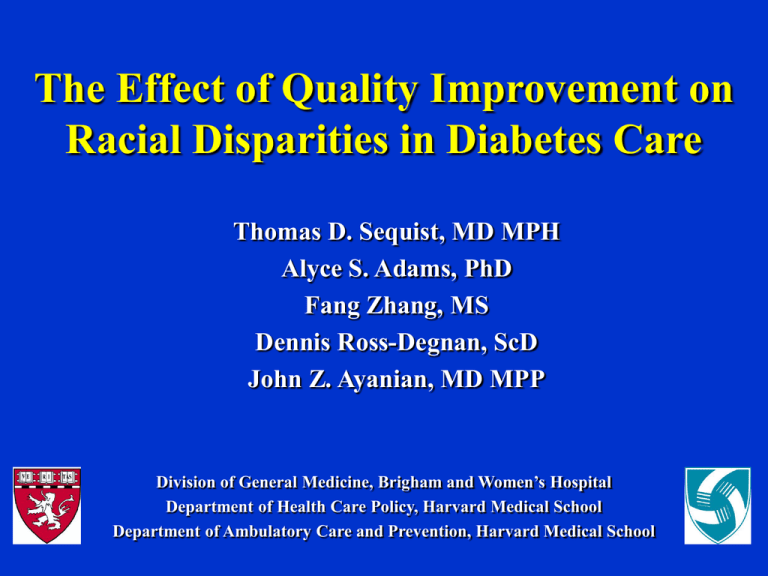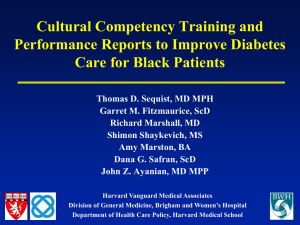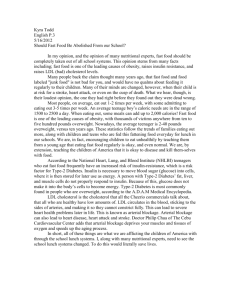The Effect of Quality Improvement on Racial Disparities in Diabetes Care
advertisement

The Effect of Quality Improvement on Racial Disparities in Diabetes Care Thomas D. Sequist, MD MPH Alyce S. Adams, PhD Fang Zhang, MS Dennis Ross-Degnan, ScD John Z. Ayanian, MD MPP Division of General Medicine, Brigham and Women’s Hospital Department of Health Care Policy, Harvard Medical School Department of Ambulatory Care and Prevention, Harvard Medical School Background Gaps between evidence and quality exist for diabetes care Racial disparities in quality well documented Generic quality improvement is a potential solution to reduce disparities Study Goals Assess baseline racial differences in diabetes care within a large multispecialty group practice Analyze impact of generic quality improvement efforts on existing racial disparities Methods – Study Site Harvard Vanguard Medical Associates Integrated multispecialty group practice – 14 health centers in Boston area – 250,000 adult patients Generic QI efforts during 1997 to 2001 – Implemented electronic health record – Computerized reminders to physicians – Disease registries/ centralized outreach to patients Methods - Study Population Adult patients 18 years with 24 months continuous enrollment in Harvard Pilgrim Health Care Diabetes diagnosis – 1 inpatient diagnosis diabetes mellitus, or – 2 outpatient diagnoses diabetes mellitus, or – Dispensing of diabetes drug (insulin, oral agent) Rolling annual cohort – 1997 to 2001 – Diagnosis of diabetes for entire calendar year Methods - Quality Measures Collected from electronic medical record Cholesterol management – Annual lipid testing – LDL control (< 130 mg/dL) – Statin dispensing (pharmacy claims) Glycemia management – Annual HbA1c testing – HbA1c control (< 7.0%) Annual retinopathy screening Methods - Analysis Baseline (1997) racial differences in care – Multivariate logistic regression – GEE to account for clustering of patients – Adjusted for age, gender Longitudinal changes in disparities – Similar to baseline models – Data included for 1997 to 2001 – Race*year interaction term Patient Characteristics White (n = 5,101) Black (n = 1,987) p value 60.2 53.8 <0.001 Male, % 51 41 <0.001 Long Term Enrollment*, % 74 73 0.44 Mean age, years * Enrolled for at least 3 out of the 5 study years % Receiving Annual LDL Testing Annual LDL Cholesterol Monitoring 100 90 80 Adjusted p<0.001 (race*year interaction) 63 70 60 50 43 46 51 20 62 53 40 30 65 35 40 29 10 0 1997 1998 1999 2000 2001 White Black LDL Cholesterol Control % Acheiving LDL < 130 mg/dL 100 90 80 Adjusted p<0.001 (race*year interaction) 70 60 50 40 40 30 20 29 18 39 21 30 19 10 0 45 9 1997 13 1998 1999 2000 2001 White Black Statin Use 100 % Prescribed Statin 90 Adjusted p=0.23 (race*year interaction) 80 70 60 50 40 30 22 26 20 10 15 18 1997 1998 30 23 35 39 27 30 2000 2001 0 1999 White Black Annual HbA1c Monitoring % Receiving Annual HbA1c 100 90 80 79 80 77 76 77 70 76 75 74 75 76 60 White Black 50 40 30 20 Adjusted p=0.11 (race*year interaction) 10 0 1997 1998 1999 2000 2001 HbA1c Control % Acheiving HbA1c < 7.0% 100 90 80 Adjusted p=0.47 (race*year interaction) 70 60 50 40 34 35 37 34 36 24 26 28 27 26 1997 1998 1999 2000 2001 30 20 10 0 White Black Dilated Eye Exams % Receiving Annual Eye Exam 100 90 80 75 71 68 69 71 66 63 65 66 70 60 71 50 40 30 20 10 Adjusted p=0.77 (race*year interaction) 0 1997 1998 1999 2000 2001 White Black Limitations Single multispecialty group practice with advanced EMR Unmeasured confounding No measures of patient experience with care Discussion Baseline disparities in diabetes care – Substantial disparity in low performing measures – No disparity in high performing measures Cholesterol management quality improvement – Reduction in process measure disparity – Less marked reduction in outcome measure disparity – Disparity in statin use persisted Glycemia management – No disparity in process measure – No quality improvement in outcome measure – Disparity in outcome measure persisted Implications Health care organizations can and should measure disparities in care Generic quality improvement may represent an effective tool to diminish disparities But…. Important to monitor outcomes measures and patterns of treatment Persistent disparities may require specific focus on minority health Electronic Reminders Centralized Patient Mailings Changes in Cholesterol Management by Gender Annual LDL Testing by Center* 1997 2001 White Black White Black in Disparity 1 36 20 63 60 13 2 39 28 68 63 6 3 42 30 68 65 9 4 50 38 68 63 6 5 38 30 64 60 4 HVMA Center * Among centers with at least 50 black patients LDL Control by Center* 1997 2001 White Black White Black in Disparity 1 15 6 41 42 10 2 13 12 52 43 (8) 3 19 9 50 41 1 4 19 6 46 33 0 5 14 10 44 41 3 HVMA Center * Among centers with at least 50 black patients







